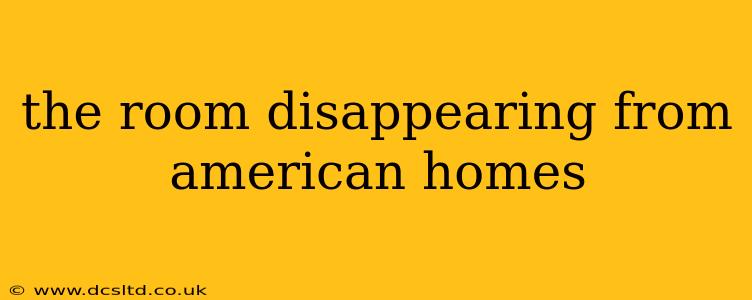The traditional formal living room, once a cornerstone of the American home, is increasingly absent from modern floor plans. This isn't just a trend; it reflects a significant shift in how we live, entertain, and utilize our living spaces. This article explores the reasons behind the decline of the formal living room, examining the changing dynamics of family life, architectural preferences, and the evolving definition of "home."
Why are formal living rooms disappearing?
This question lies at the heart of the matter. The answer isn't simple, but rather a confluence of factors:
-
Changing Lifestyles: Our lifestyles are less formal than previous generations. Open-concept living spaces prioritize family interaction and fluidity, replacing the rigid separation of formal and informal areas. The need for a dedicated, rarely-used "company" room is diminishing as casual gatherings replace stiff, structured entertaining.
-
Shifting Priorities: Homebuyers are prioritizing other features over a formal living room. Features like larger kitchens, outdoor living spaces, home offices, and extra bedrooms are often considered more essential for modern family needs. The square footage once dedicated to a formal living room is now reallocated to meet these evolving demands.
-
Architectural Trends: Open-plan designs have become dominant in new home construction. These designs emphasize flow and connectivity between spaces, blurring the lines between the kitchen, dining area, and living area. This creates a more welcoming and sociable environment, making the formal living room seem redundant.
-
Flexible Living Spaces: Homeowners seek versatility in their living spaces. The dedicated formal living room, often underutilized, is less appealing when compared to flexible spaces that can adapt to various activities – from family game nights to home office setups.
-
Increased Value of Outdoor Spaces: Backyards, patios, and decks are gaining prominence as extensions of living spaces. Outdoor entertaining and relaxation are increasingly prioritized, reducing the need for a separate, formal indoor entertaining space.
What replaced the formal living room?
The space once occupied by the formal living room is often repurposed in several ways:
-
Open-Concept Living Areas: These spaces combine the kitchen, dining area, and living area into one large, flowing space, promoting social interaction.
-
Home Offices: The rise of remote work has led to a significant increase in demand for dedicated home office spaces.
-
Playrooms/Family Rooms: Larger, more versatile family rooms are replacing formal living rooms, offering spaces for family activities and entertainment.
-
Guest Bedrooms: In some homes, the formal living room is converted into an extra bedroom to accommodate guests or family members.
Is the formal living room completely gone?
While the prevalence of formal living rooms has significantly decreased, they haven't entirely vanished. Some homeowners still value the elegance and formality of a dedicated living room, particularly in larger homes or those with a more traditional architectural style. However, even in these instances, the function and use of the formal living room may be more relaxed and less rigidly defined than in previous generations.
What about older homes with formal living rooms?
Owners of older homes with formal living rooms often find creative ways to repurpose the space to suit their modern needs, while retaining some of its original charm.
Are there any benefits to having a formal living room?
While less common, some potential benefits of maintaining a formal living room include:
- A quiet space for relaxation: It can serve as a dedicated space for quiet reflection or reading.
- Formal entertaining: For those who still enjoy formal entertaining, it provides a dedicated space for hosting guests.
- Preservation of architectural character: In older homes, maintaining the formal living room can preserve the home's original character and architectural integrity.
The disappearance of the formal living room from American homes reflects a broader cultural shift towards more casual and flexible living arrangements. While the traditional formal living room might be less common, the spaces that replace it reflect our evolving needs and priorities in creating a comfortable and functional home environment.
